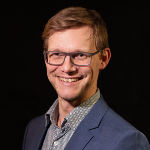In the context of moiré superstructures, various models have been proposed for the low-energy bands of twisted materials. These have also to some extent be analyzed numerically, especially at integer fillings and with mean-field approaches.
The master thesis should throw more sophisticated numerical methods at the models.
- Quantum Monte Carlo often has a sign problem, leading to extremely
poor convergence. - Classical Monte Carlo leaves out entanglement
It turns out, however, that some variants of short-range entanglement can be
treated with a 'quasi-classical' algorithm, where the classical variables of the
Monte-Carlo algorithm encode the real and imaginary parts of coefficients of
the local wave function.
The approach is to be used on spin-orbit coupled systems, in order to allow a
full quantum-mechanical description of on-site entanglement between spin and
orbital moment.
The master thesis is to investigate the fate of the 'topological pinball
liquid', which combines topological and charge order, in the presence of a spin degree of freedom. Mixing of Chern bands with C = ±1 is integral to the state, but the impact of spin has not yet been studied.
The model is to be supplemented with a second copy for the opposite spin, with Chern numbers turned around. The impact of band mixing and spin degree of
freedom on the ground state is to be investigated. In particular, the
competition and synergy of charge-density waves of fractional Chern insulators is
here of interest, as these issues also arise in moiré materials.
Pump-probe experiments offer insights into the dynamics of a system that might
no be available in equilibrium. The Master thesis should simulate light-driven
excitations of charge-transfer systems in a pump-probe setting. Broken
inversion symmetry allows light to induce d-d excitations, whose impact on
magnetic excitations is to be investigated.
Energy- and momentum-dependent correlation functions, which are accessible to
various experimental probes, have in recent years been used to extract
entanglement information for quantum spin models. In this thesis, this
approach is to be investigated for a number of models for quantum magnetism:
In which cases can one expect to find signatures of entanglement that are
accessible to experiment and which correlation functions should be probed?
Entanglement is at the core of modern quantum mechanics and can be related to
correlation functions. The thesis should numerically investigate the case of
two spins coupled to either a metal or a superconductor: If spins are strongly
coupled to each other, they form a highly entangled singlet. If, on the other
hand, coupling of each spin to the bath dominates, they will be less
entangled. Questions to be studied are the signatures of these transitions (or
crossover) that might be accessible to experiment via measurable correlation functions.
Superconductivity with carriers different from charge-2e cooper pairs is an
intriguing but rather remote possibility. Recently, charge-4e superconductivity
was discussed in the context of a two-band Hubbard model. In this thesis, it
is to be investigated (using numerical and analytic approaches) whether a
slight generalization allows the scenario to host charge-4e d-wave
superconductivity as well.
In this Master's thesis, the Kondo-lattice model with quantum localized spins on the triangular lattice is to be investigated. The method to be used is the variational cluster approach (VCA). Questions to be discussed here include the stability of non-coplanar magnetic order and triplet superconductivity. Moreover, the impact of quantum fluctuations can be studied.
For detailed information click here.
In this Master's thesis, non-equilibrium processes should be simulated on the triangular lattice in two dimensions. The aim is to find equilibrium phases and identify non-equilibrium states.
For more information please click here.
In this Master's thesis,the spectral density for one charge carrier in t-J models is to be studied using cluster-perturbation theory, where the description of the antiferromagnetic background is to be reformulated from spins into bosons.
For more information please click here.
In this Master's Thesis, the Kugel-Khomskii model for one electron should be studied on the honeycomb lattice for increasing spin-orbit coupling strength and varying Hund's rule coupling. To this effect, the Hamiltonian has to be extended and analyzed by exact diagonalization methods.
For more information please click here.
For more information on possible subjects, please contact Prof. Dr. Maria Daghofer.
Contact

Sebastian Loth
Prof. Dr.Head of Institute FMQ1 (managing director)

